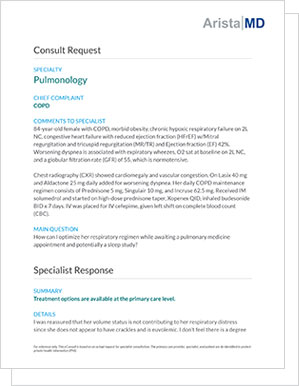SPECIALTY
Pulmonology
CHIEF COMPLAINT
COPD
COMMENTS TO SPECIALIST
This pulmonology consult is for an 84-year-old female with COPD, morbid obesity, chronic hypoxic respiratory failure on 2L NC, congestive heart failure with reduced ejection fraction (HFrEF) w/Mitral regurgitation and tricuspid regurgitation (MR/TR) and Ejection fraction (EF) 42%. Worsening dyspnea is associated with expiratory wheezes, O2 sat at baseline on 2L NC, and a globular filtration rate (GFR) of 55, which is normotensive.
Chest radiography (CXR) showed cardiomegaly and vascular congestion. On Lasix 40 mg and Aldactone 25 mg daily added for worsening dyspnea. Her daily COPD maintenance regimen consists of Prednisone 5 mg, Singulair 10 mg, and Incruse 62.5 mg. Received IM solumedrol and started on high-dose prednisone taper, Xopenex QID, inhaled budesonide BID x 7 days. IV was placed for IV cefepime, given left shift on complete blood count (CBC).
MAIN QUESTION
How can I optimize her respiratory regimen while awaiting a pulmonary medicine appointment and potentially a sleep study?
For reference only. This eConsult is based on an actual request for specialist consultation. The primary care provider, specialist, and patient are de-identified to protect private health information (PHI).
Five Ways eConsults Support Value-Based Care

Combine your referral management platform with an eConsult solution to reduce patient wait times and the cost of care. Learn five ways our eConsults support value-based care by allowing primary care physicians, nurse practitioners or PAs to submit electronic requests for patient advice to our team of specialists to manage low-acuity patients.
1. Help patients avoid unnecessary face-to-face specialty visits
About 70% of eConsults can address what physicians typically send for a face-to-face specialty visit. As a web-based physician-to-physician consultation, there is no need for any particular technology or integration — the PCP orders the referral the same way they would traditionally order one. Or suppose the patient was to go face-to-face for a specialty consult with the provider using our referral nurse coordination, RNN service, and nurse navigators. In that case, our nurse will curate the eConsults by grabbing all of the data needed for the patient from the chart. Private health information is then sent to our specialist, who reviews the data and provides an evidence-based response on that patient’s best practice and management. Within four to six hours, the primary care provider receives a notification and can view the eConsult specialist’s recommendations.
The bottom line — for every specialty visit where we serve the patient using an eConsult and address issues through the primary care provider, we can fend off the need for three face-to-face visits. Also, once you gain specific knowledge from a specialist on a particular condition, you have the answer to the same question when it comes up again.
GET IN TOUCH
Ready to deliver lower-cost care without sacrificing quality?

